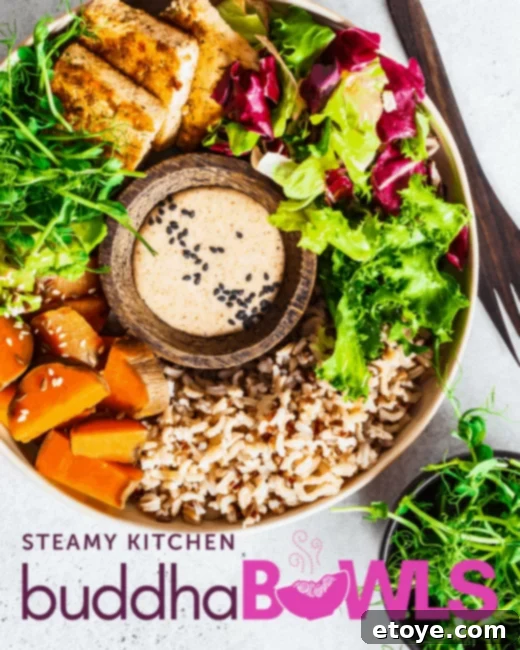Unlock a vibrant spectrum of flavors and nourishment with this spectacular **Rainbow Buddha Bowl**, beautifully complemented by a zesty **Tahini-Lemon Dressing**. This recipe isn’t just about combining ingredients; it’s an invitation to craft a visually stunning and incredibly healthy meal that delights both the eyes and the palate. Imagine a bowl brimming with a kaleidoscope of vegetables, hearty grains, and satisfying protein, all brought together by a creamy, tangy dressing that elevates every bite. It’s the perfect one-bowl wonder for anyone seeking a wholesome, plant-forward dish that’s easy to customize and packed with goodness.
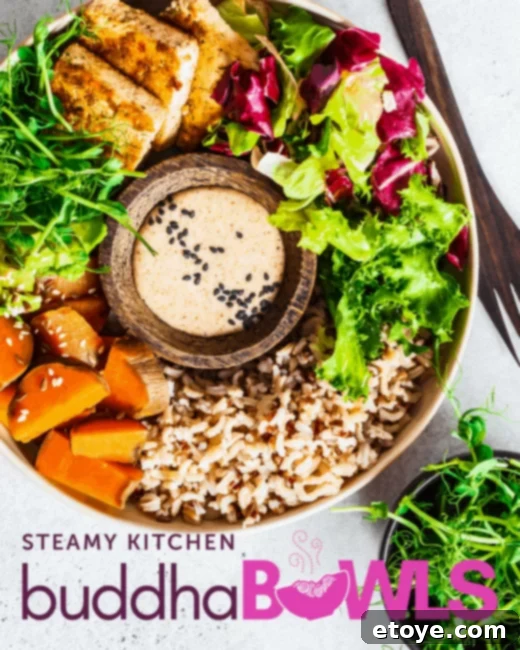
Embracing the Buddha Bowl Lifestyle: A Guide to Wholesome Eating
Buddha bowls, sometimes called “power bowls” or “glory bowls,” have surged in popularity, and for good reason. They represent a philosophy of mindful eating, encouraging the assembly of a balanced, nutritious meal in a single bowl. The concept is simple yet brilliant: a foundation of grains, topped with a generous array of fresh and cooked vegetables, a source of protein, and a flavorful dressing, often finished with a crunchy element. This approach makes meal planning straightforward and allows for endless creativity, adapting to whatever fresh ingredients you have on hand.
What truly makes each Buddha bowl unique and memorable is its signature sauce and a satisfying crunchy topping. These elements are not just add-ons; they are the catalysts that bind the diverse textures and flavors, transforming a collection of ingredients into a harmonious and exciting dish. Our Rainbow Buddha Bowl embraces this philosophy, guiding you through creating a masterpiece that is as delightful to look at as it is to eat. It’s an ideal meal for any time, offering convenience without compromising on health or taste.

Whether you’re a seasoned chef or a beginner in the kitchen, the beauty of Buddha bowls lies in their adaptability. They empower you to experiment with different combinations, ensuring that every meal is a personalized culinary adventure. This flexibility also makes them perfect for meal prepping, allowing you to prepare components in advance and assemble fresh bowls throughout the week. Let’s dive into the essential components that make our Rainbow Buddha Bowl truly shine.

Crafting Your Rainbow Buddha Bowl: Essential Layers for a Perfect Meal
To create a truly balanced and delicious Rainbow Buddha Bowl, we recommend focusing on these key layers. Each component plays a crucial role in delivering a symphony of textures, nutrients, and flavors, ensuring every mouthful is satisfying and wholesome.
- Grain: The Hearty Foundation
Here’s an excellent opportunity to explore ancient grains. We highly recommend freekeh, a roasted green durum wheat with a delightful chewy texture and nutty flavor. Its Middle Eastern origins make it a perfect pairing for tahini-based dressings. Freekeh is not only delicious but also a nutritional powerhouse, rich in fiber and protein, contributing to sustained energy. For an extra touch that truly embodies the “rainbow” theme, consider multi-colored quinoa. Quinoa is a complete protein and comes in various shades, adding visual appeal and a slightly different texture to your bowl. Both options provide a robust base that will keep you feeling full and satisfied. - Vegetables: The Vibrant Spectrum of Health
This is where your Buddha bowl truly comes alive with color and nutrients. Aim for a diverse selection, incorporating something red, yellow, green, violet, and everything in between! The key is to combine different textures. Think crisp and leafy elements like fresh gem lettuce, thinly sliced radishes, or shredded red cabbage, offering a delightful crunch. Balance these with more substantial, fleshy vegetables such as tender roasted sweet potatoes or ripe cherry tomatoes. Sweet potatoes, packed with vitamins and antioxidants, add a comforting sweetness and depth. Don’t forget a bright garnish like fresh parsley or cilantro to add a final pop of color and herbaceous note. The more colors you include, the wider the range of vitamins, minerals, and antioxidants you’ll consume. - Protein: The Satisfying Core
Protein is essential for satiety and muscle health. Firm tofu is a fantastic, versatile choice that readily absorbs flavors, making it incredibly easy to customize. Pressing out excess water before cooking helps it achieve a perfect texture. If you’re looking for flavorful alternatives for this Rainbow Buddha Bowl, consider pan-fried Halloumi cheese for a salty, squeaky bite, or a generous serving of sautéed spiced chickpeas for an earthy, fiber-rich option. Inspired by the vibrant flavors of Mediterranean cuisine, crispy falafel is another excellent choice, adding a delightful crunch and savory taste, much like those found at an amazing falafel salad bar. - Sauce: The Unifying Elixir
The sauce is the soul of any Buddha bowl, and our Tahini-Lemon Dressing is no exception. If you’ve ever wondered about the hype surrounding tahini, now is your chance to discover its magic! This rich yet wonderfully tangy dressing is incredibly versatile, brightening up every component it touches. We’ll show you how to prepare a perfectly balanced sauce that perfectly complements the myriad of flavors and textures in your bowl, tying everything together into a cohesive, delicious meal. - Topping: The Irresistible Crunch
Every great Buddha bowl needs a textural contrast, and a crunchy topping is key. Drawing inspiration from hummus, a beloved tahini-based dip, we opt for roasted chickpeas. What is hummus without chickpeas, after all? These little golden nuggets, whether homemade or store-bought, offer a fantastic crunch and an extra boost of plant-based protein and fiber. They provide that satisfying bite that completes the meal, making it truly irresistible.
Now, let’s begin assembling this incredible Buddha Bowl…
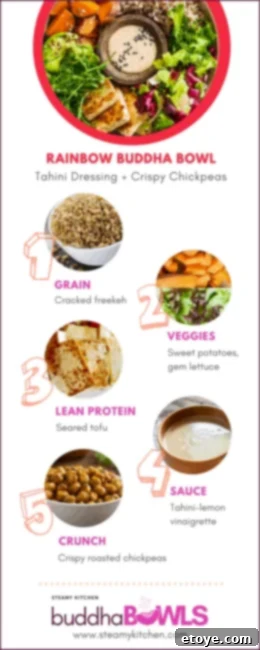
Discovering Freekeh: The Ancient Grain Powerhouse
Freekeh, an ancient grain with roots in Middle Eastern cuisine, is gaining recognition for its unique flavor and impressive nutritional profile. It’s made from young, green durum wheat that is roasted, then rubbed to remove the husk, giving it a distinctive smoky flavor and chewy, nutty texture. Typically, freekeh is available in two main varieties: cracked and whole.
Cracked freekeh is significantly quicker to cook than its whole counterpart, requiring approximately 20 minutes compared to 45 minutes for whole freekeh. This makes it an ideal choice for busy weeknights when you want a nutritious meal without a long cooking time. Crucially, this quicker cooking process does not compromise its nutritional content; both varieties are rich in fiber, protein, and essential minerals, making freekeh an excellent complex carbohydrate choice for your Buddha bowl.
Beyond its culinary appeal, freekeh boasts several health benefits. Its high fiber content aids digestion, promotes satiety, and helps regulate blood sugar levels, contributing to overall well-being. It’s also a good source of iron, magnesium, and zinc. Its low glycemic index makes it a smart choice for maintaining stable energy levels, making your Buddha bowl a truly energizing meal.

Thanks to the growing popularity of “ancient grains,” freekeh is becoming increasingly accessible. You can often find it in the grain or natural foods aisle of most major grocery stores and health food stores. For an even wider selection and potentially better prices, check out international markets that specialize in Middle Eastern dry goods. When purchasing, look for reputable brands to ensure quality.
Perfectly Cooking Freekeh: Simple Steps for a Flavorful Grain
Cooking freekeh is surprisingly straightforward, akin to preparing quinoa, but often less messy due to its slightly larger grain size. Follow these simple steps to ensure your freekeh is perfectly tender and flavorful, providing an excellent base for your Rainbow Buddha Bowl:
- **Rinsing:** Before cooking, it’s a good practice to rinse freekeh under cold running water in a fine-mesh sieve. This helps remove any dust or small debris.
- **Proportions:** For optimal results, place 1 cup of freekeh in a pot with approximately 2 ½ cups of liquid. You can use water for a neutral base or vegetable broth for added depth of flavor.
- **Seasoning:** Add a pinch of salt to the pot. This enhances the grain’s natural flavor.
- **Bringing to a Boil:** Bring the mixture to a boil over medium-high heat.
- **Simmering:** Once boiling, stir once, then reduce the heat to the lowest setting. Cover the pot tightly and let it simmer for about 15 to 20 minutes, or until the freekeh is tender and all the liquid has been absorbed. Avoid lifting the lid too often to allow the steam to cook the grains effectively.
- **Fluffing:** Once cooked, remove the pot from the heat and let it sit, covered, for another 5 minutes. Then, gently fluff the freekeh with a fork before serving.
Chef’s Tip: For an extra layer of flavor and to prevent the grains from drying out if you’re preparing them ahead of time, add a few spoonfuls of olive oil or a knob of butter to the water before cooking. This also helps separate the grains, resulting in a perfectly textured freekeh.
Preparing the Rainbow of Vegetables: Freshness and Flavor in Every Bite
One of the joys of building a Buddha Bowl is the minimal effort often required for vegetable preparation, especially when embracing the beauty of fresh, raw produce. Many of the vegetables for this vibrant bowl can be last-minute additions, offering convenience and maximizing nutrient retention. Think crisp raw tomatoes, thinly sliced radishes for a peppery kick, vibrant green salad greens, or even purple or red cabbage shredded finely for color and crunch. These fresh elements add an immediate burst of flavor and texture without extensive cooking.
However, for a more substantial and comforting element, **roasted sweet potatoes** are a game-changer. Their natural sweetness and tender texture create a delightful contrast to the crispier components in your bowl. Baking sweet potatoes is simple and yields fantastic results. To ensure they cook quickly and evenly, chop them into bite-sized pieces or wedges. Roast them at 375 degrees F (190 degrees C) for approximately 20 minutes, or until they are tender and slightly caramelized. A light drizzle of olive oil, salt, and pepper is all they need to transform into a delicious addition.
For those looking to expand their vegetable repertoire, consider other quick-cooking options like steamed broccoli florets, sautéed spinach, or lightly blanched green beans. The goal is to maximize variety and visual appeal, ensuring a broad spectrum of vitamins and antioxidants in every serving. Don’t be afraid to mix and match based on seasonality and personal preference.
Take a look at how to cut them for the quickest bake:

For more inspiration on incorporating delicious roasted vegetables into your meals, explore our Roasted Vegetable Buddha Bowl recipe.
The Magic of Tahini Dressing: A Zesty and Creamy Delight
Tahini, a staple in Middle Eastern and Mediterranean cuisines, is the star ingredient of our vibrant Tahini-Lemon Dressing. This incredibly versatile paste is made simply from finely ground, toasted white sesame seeds. Imagine it as a rich, savory sesame seed butter – typically nut-free, and often free of added sugars or salts, allowing the pure, natural oils and intense flavor of pulverized sesame to shine through. Its distinctive earthy, slightly bitter, and deeply savory profile makes it an exceptional base for dressings, dips, and sauces.
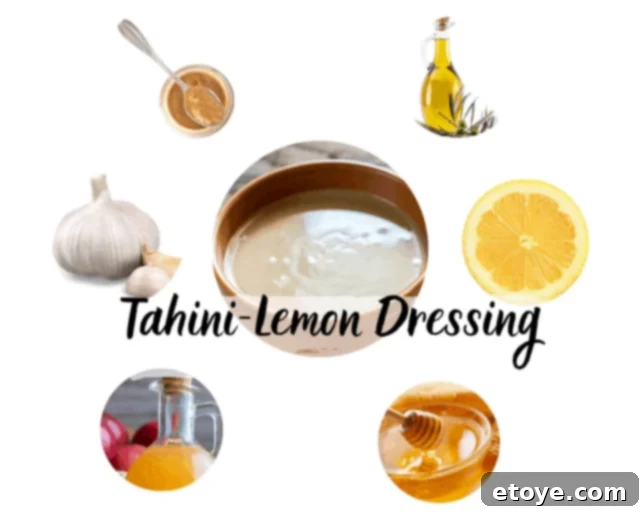
You might be most familiar with tahini through its essential role in creating smooth, creamy hummus. While it’s a key player in many traditional dishes, its culinary applications extend far beyond. A little tahini goes a long way, and its rich texture and complex flavor make it an easy and rewarding addition to a wide array of sauces and dressings, lending a depth that is truly unique. It’s also a fantastic source of healthy fats, protein, and minerals like calcium and iron.
Our Tahini-Lemon Dressing for this Rainbow Buddha Bowl is a testament to tahini’s versatility. It’s neither overly sweet nor too rich, striking a perfect balance of tangy and fragrant notes that beautifully complement any assortment of vegetables. This bright and zesty vinaigrette combines the following ingredients, transforming your bowl into a culinary masterpiece:
- 1/4 cup tahini (choose a high-quality, smooth tahini for best results)
- 2 tablespoons extra-virgin olive oil (adds richness and a fruity note)
- 2 tablespoons fresh lemon juice (essential for brightness and tang)
- 1 tablespoon honey (or maple syrup for a vegan option, to balance the tartness)
- 1 tablespoon apple cider vinegar (enhances the tang and adds complexity)
- 1 clove garlic, minced (for aromatic depth)
- 1/2 teaspoon kosher salt (to taste, enhances all flavors)
- 1/4 teaspoon freshly ground black pepper (for a subtle kick)
- 1 tablespoon cold water (or more, as needed, to reach desired consistency)
To prepare the dressing, simply whisk all the ingredients together in a small bowl until thoroughly combined and smooth. The mixture might initially thicken as the tahini emulsifies, but gradually adding cold water will help thin it out to your desired consistency. Taste and adjust the seasoning with more salt and pepper as you like. For a truly smooth dressing, you can also blend it briefly in a food processor or with an immersion blender.
Given its fresh ingredients, particularly lemon juice and garlic, this tahini dressing is best enjoyed within 3-5 days. Store it in an airtight container in the refrigerator to maintain its freshness and vibrant flavor. It’s a wonderful dressing to have on hand for salads, wraps, or as a dip.
The Perfect Crunch: Elevating Your Buddha Bowl with Roasted Chickpeas
While our tahini takes a star turn in the dressing, we certainly wouldn’t want chickpeas, its beloved partner in hummus, to miss out on the party! Incorporating a crunchy topping is crucial for adding textural contrast and making your Buddha Bowl an even more engaging and satisfying meal. Roasted chickpeas, also known as garbanzo beans, are the ideal candidate for this role.
When roasted with a touch of salt and your favorite spices, chickpeas transform into irresistible, snackable golden nuggets. Their outer layer becomes delightfully crisp, while the inside remains tender, creating a satisfying crunch that elevates the entire dish. You can easily prepare them at home, or for ultimate convenience, you can also purchase prepackaged roasted chickpea snacks online or in many grocery stores.
These crunchy chickpeas pack a significant bite. If you prefer a finer, more varied texture, consider lightly crushing them with a pestle and mortar or a durable food processor before sprinkling them over your Buddha bowl. This will introduce serious textural variety, from whole crispy beans to smaller, crumbly bits, enhancing the eating experience. Beyond texture, chickpeas are a nutritional powerhouse, rich in plant-based protein, dietary fiber, and essential minerals, contributing to satiety and digestive health.

What’s more, homemade roasted chickpeas are excellent for meal prep. Once cooled, they can be stored for up to several months in an airtight container in your pantry, making them a ready-to-use topping whenever you need a boost of flavor and crunch. They’re incredibly versatile: crush them over creamy soups for added texture, sprinkle them on green salads for extra protein, or simply enjoy them whole as a healthy snack on their own. Their versatility and shelf stability make them a must-have in your pantry.
For a detailed guide on making your own perfectly crisp roasted chickpeas, be sure to check out our easy recipe for Crispy Roasted Chickpeas.
Useful Resources and Recipes for Your Buddha Bowl Journey
To further enhance your culinary skills and expand your recipe collection, we’ve compiled a list of useful links related to various components of this delicious Buddha bowl:
- Make your own tahini for the freshest taste.
- Find quality extra-firm tofu for perfect searing.
- Master the art of pan-frying tofu for crispy results – a Steamy Kitchen favorite.
- Learn how to cook halloumi cheese to perfection.
- Discover an easy recipe for Air Fryer Falafel for a quick protein option.
- Get our detailed Crispy Roasted Chickpeas recipe – another Steamy Kitchen essential.
- For convenience, find prepackaged roasted chickpeas.
Beyond the Bowl: More Delicious Uses for Tahini
Tahini is a truly versatile ingredient that extends its magic beyond just this Buddha bowl. Here are some other delightful ways to incorporate tahini into your cooking:
- Whip up Smoky Hummus with Baked Tortilla Chips – a classic application from Steamy Kitchen.
- Experiment with a bold Tahini Sauce with Too Much Garlic for a pungent, flavorful experience.
- Satisfy your sweet tooth with unique Chewy Tahini Blondies, showcasing tahini’s ability to shine in desserts.
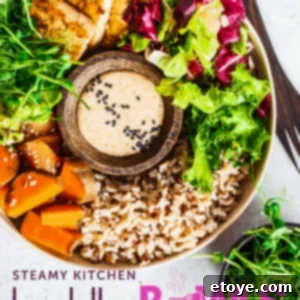
Rainbow Buddha Bowl with Tahini-Lemon Dressing
Pin Recipe
Ingredients
For the GRAINS
- 2 ½ cups water or vegetable broth
- 1 cup freekeh cracked, or whole grain for longer cooking time
- ½ teaspoon salt
For the VEGETABLES
- 4-6 cups gem lettuce, cooked sweet potatoes, sliced radishes, red cabbage, or tomato
For the PROTEIN
- 1 16-ounce container extra-firm tofu or falafel, halloumi cheese
- kosher salt to taste
- 1 tablespoon cooking oil
For the VINAIGRETTE
- 1/4 cup tahini
- 2 tablespoons extra-virgin olive oil
- 2 tablespoons fresh lemon juice
- 1 tablespoon honey
- 1 tablespoon apple cider vinegar
- 1 clove garlic minced
- 1/2 teaspoon kosher salt to taste
- 1/4 teaspoon freshly ground black pepper to taste
- 1 tablespoon cold water as needed
For the CRUNCH
- 3/4 cup roasted chickpeas
Instructions
- Combine water, freekeh, and salt in a pot. Bring to a boil over medium-high heat. Stir, reduce heat to medium-low, and simmer, covered, 15 to 20 minutes or until freekeh is tender and has absorbed the liquid.
- Microwave the tofu block on a plate for 2 to 3 minutes, or until it releases a good amount of moisture. Discard liquid and slice tofu into thick slices or cubes. Season on both sides with salt and pepper. Heat oil in a large pan over medium-high heat and sear tofu until golden brown and crispy, about 3 minutes per side.
- Whisk vinaigrette ingredients together, adding more water as needed to thin out the mixture. Refrigerate until ready to use. Dressing keeps for up to 5 days.
- To assemble the bowls, scoop freekeh into 4 large bowls. Arrange vegetables and tofu on top. Drizzle in the vinaigrette and scatter chickpeas on top.
